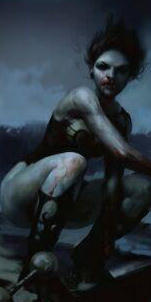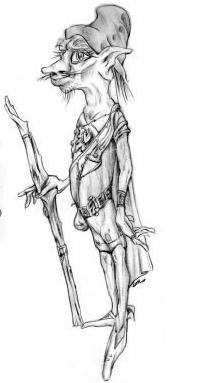Menu
Home
Deities
Morts
Clans
Race
Class
Telnet
Help
Email
Give

Races
Cent
Cyclop
Draco
Dryad
Dwarf
Elf
Fiend
Giant
Gno
Goblin
Half
Hum
Illythid
Lizard
Pixie
Shad
Troll

Menu
Home
Deities
Morts
Clans
Race
Class
Telnet
Help
Email
Give

Races
Cent
Cyclop
Draco
Dryad
Dwarf
Elf
Fiend
Giant
Gno
Goblin
Half
Hum
Illythid
Lizard
Pixie
Shad
Troll

|
|
More on Gnomes

 Gnomes do share some traits with their Dwarf
cousins. They are exceptional miners, comfortable
underground, and resistant to magic. Gnomes are
quite comfortable out of doors, well at home in a
forest. Gnomes are also cheerful and social
creatures, of good tempered and tolerant
disposition. They regard rudeness as a major
fault a characteristic which in itself is enough to
mark them as very different from most Dwarves.
Gnomes relish the company of others and will
eagerly compete in the telling of tales. Their
calendar is marked by many festivals, each of
which is an occasion of great feasting, drinking,
singing, and dancing. Although gnomes are
friendly, they are also reticent, it is possible
to know a gnome for many years without
learning much about him. When a gnome does
become friends with a member of another race, that person is adopted by
the gnome's whole family as someone they like and trust. Gnomes have
much to fear from the larger creatures of the world, but they have not
allowed this caution to become a compelling paranoia. It is when the work
is done that the true nature of gnomehood becomes apparent. No one
could mistake a boisterous gathering of singing, dancing gnomes for a
hard working bunch of dwarves. The first half century of a gnome's life
is generally spent in a carefree childhood. Youngsters are indulged and
benignly guided by their elders, with rarely a harsh word or punishment
employed against them. The children learn by example and strive to please
the adults around them. Sages attribute the fact that all gnomes respond
better to praise and encouragement than threats to this upbringing. By the
time he or she has reached 50 years of age, a gnome is expected to begin
applying himself or herself to the development of a useful skill and to learn
the basics of self defense and weaponcraft. However, during this half
century long adolescence, gnomes are still not subjected to an array of
responsibilities instead, they are encouraged to experiment with a variety
of trades and activities until they find those best suited to their own
talents and personality.
Gnomes do share some traits with their Dwarf
cousins. They are exceptional miners, comfortable
underground, and resistant to magic. Gnomes are
quite comfortable out of doors, well at home in a
forest. Gnomes are also cheerful and social
creatures, of good tempered and tolerant
disposition. They regard rudeness as a major
fault a characteristic which in itself is enough to
mark them as very different from most Dwarves.
Gnomes relish the company of others and will
eagerly compete in the telling of tales. Their
calendar is marked by many festivals, each of
which is an occasion of great feasting, drinking,
singing, and dancing. Although gnomes are
friendly, they are also reticent, it is possible
to know a gnome for many years without
learning much about him. When a gnome does
become friends with a member of another race, that person is adopted by
the gnome's whole family as someone they like and trust. Gnomes have
much to fear from the larger creatures of the world, but they have not
allowed this caution to become a compelling paranoia. It is when the work
is done that the true nature of gnomehood becomes apparent. No one
could mistake a boisterous gathering of singing, dancing gnomes for a
hard working bunch of dwarves. The first half century of a gnome's life
is generally spent in a carefree childhood. Youngsters are indulged and
benignly guided by their elders, with rarely a harsh word or punishment
employed against them. The children learn by example and strive to please
the adults around them. Sages attribute the fact that all gnomes respond
better to praise and encouragement than threats to this upbringing. By the
time he or she has reached 50 years of age, a gnome is expected to begin
applying himself or herself to the development of a useful skill and to learn
the basics of self defense and weaponcraft. However, during this half
century long adolescence, gnomes are still not subjected to an array of
responsibilities instead, they are encouraged to experiment with a variety
of trades and activities until they find those best suited to their own
talents and personality.
The industrious nature of gnomes is well documented, and probably
represents their closest similarity to dwarves. Like dwarves, gnomes will
organize for a task, with each individual lending his or her talents where
they will be most useful. In their pursuit of mining, gnomes are not so
speedy to excavate as dwarves, but they are more careful with what they
find. Indeed, many a vein of ore that has been played out by Dwarven
standards has been taken over by gnomes and continued to yield its riches
to the more meticulous gnomish miners. Even while they work however these
gnomes will pursue their tasks with high good humour, bawdy stories, and a
succession of jokes of all types. Only rarely however will this frivolity
interfere with the effectiveness of the group's work.
Nowhere is Gnome precision more in evidence than in their stonecutting
and gemwork. Their skill at cutting, polishing, and mounting gemstones is
unsurpassed by any other race. They are also skilled enough metalworkers
to make elaborate frames and mounts for jewelry. Indeed, gnomish
metalsmiths work better with soft metals such as silver and gold than they
do with iron and steel another significant difference between them and
their larger cousins the dwarves. This is not to say that gnomes cannot
become fine blacksmiths when they are so inclined. Indeed, every community
will have at least one well muscled resident who is in charge of tool making
and of crafting other objects such as dishes and weapons out of iron and
steel. Gnomes generally purchase steel from dwarves or humans however
rather than smelting it themselves. The finest weapons in a gnomish
community are generally of outside (dwarven or elven) manufacture, often
purchased in trade with the gem and jewelry work that they do so well.
Upon reaching adulthood, the Gnome must select a guild for himself or
herself. The number of guilds available varies by location, and include
virtually all areas of practical endeavour, and quite a few impractical ones
as well: Weaponry, Steam Power, Hydraulics, Mathematics, Agriculture,
Warmaking, Animal Taming, Brewing, Carpentry, Astronomy, Ceramics
(Rockmaking), Air Utilization, Historians, Coalmining, Rockcarving, Vehicle
Design, and Music.
Their communities are located underground, but always close to the surface,
with plenty of access to fresh air. Their penchant for burning coal to
achieve steam makes good ventilation necessary. The various chambers of a
gnome community will be connected by various means of transport, powered
by steam, spring power, wind, water, gravity, and any other means available.
Types include cars that run along rails or are suspended from cables and
pulleys, soaring gliders, elevators that run up and down through shafts
bored through rock, and independently-steered carts and cycles propelled
by various means. For private living quarters, Gnomes are inclined to settle
for any old niche in the wall that can be closed off for a little privacy.
They like to sleep in absolute darkness but have absolutely no trouble
slumbering amid a thunderous cacophony of noise. Far more important than
his or her bedroom, to a Gnome, is his or her workshop. This area will be a
private chamber, if the gnome is influential enough to warrant such a luxury,
or if he or she inherits it from a deceased parent.
|
|
|
|






